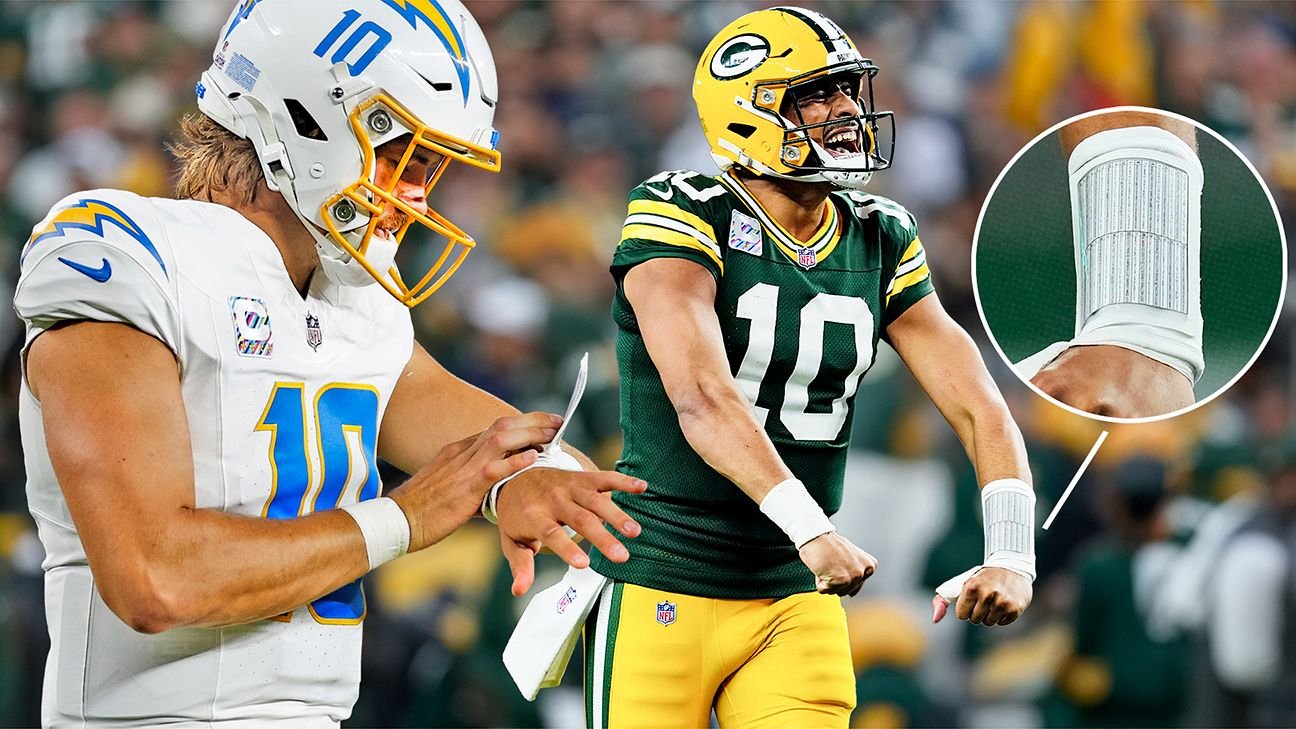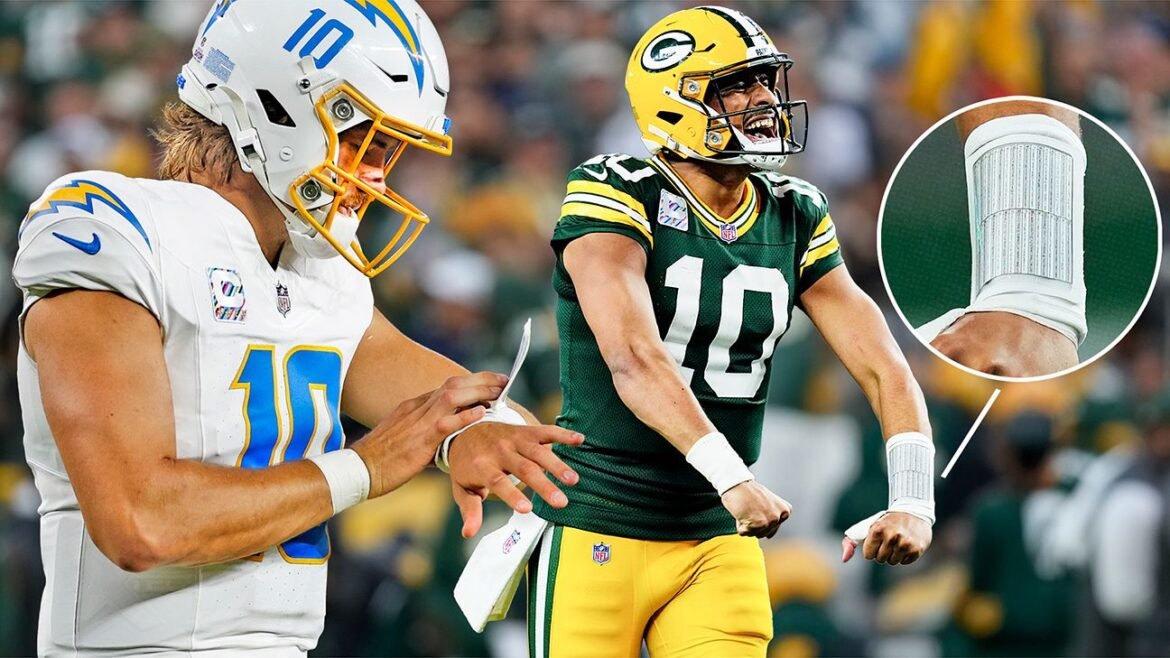
The Cincinnati Bengals needed a spark.
Trailing AFC North rival Pittsburgh by 10 after Ja’Marr Chase‘s touchdown catch was reversed by replay, Bengals quarterback Joe Flacco received the call over his headset, flipped open his wristband and quickly glanced down as players gathered in the huddle.
Flacco, who was traded from Cleveland to Cincinnati nine days earlier, has heard thousands of calls over his 18-year NFL career. But different teams use different verbiage, so the play sheet on his left wrist was crucial.
On the next play, Flacco went back to Chase and lofted a ball to the left corner of the end zone for an 8-yard touchdown. It was the first of three TD passes as Flacco led the Bengals to a 33-31 Week 7 victory.
Flacco is one of 20 current starting NFL quarterbacks who wear a wristband play sheet. Quarterbacks and coaches from 18 teams were asked about the device’s pros and cons. Its biggest advantage is allowing a coach to quickly call in a number instead of a play, which can be lengthy. Other signal-callers, such as Dallas Cowboys quarterback Dak Prescott, don’t use one because they value eye contact with teammates while calling a play.
“When I first started using a wristband, there’s a piece of it that was harder because instead of saying [the call] and picturing it as you’re saying it, you’re just reading words,” Flacco said. “And then you kind of have to go back and think — what did I just say?”
The first wristband was worn in 1965 by Tom Matte, a running back-turned-emergency quarterback for the Baltimore Colts. After injuries to Johnny Unitas and backup Gary Cuozzo decimated the Colts’ quarterback room, coach Don Shula tabbed Matte to run the offense. Matte had played quarterback at Ohio State but never in the NFL, so Shula sent his third-string QB into the game against the Rams with a simplified version of the offense written on a card covered by plastic on a wristband.
The Colts won that game 20-17, and Shula’s innovation sparked a trend. Some of the game’s greatest quarterbacks, from Tom Brady to Patrick Mahomes, have worn wristbands so they can access the playbook in games and confirm the call they’re receiving from the sideline.
These condensed call sheets are jam-packed with information. Menus of base runs, third-down plays, dropback passes, empty formation calls, alerts and directions are loaded onto cards that fit inside terrycloth wristbands.
The shorthand version of “0 Out Slot 62 F Slim Z Montana Flare” would read “38” on the wristband Brady used during his time with the New England Patriots.
The decision to wear a wristband is often a joint one between playcaller and quarterback. Some offenses mandate that every quarterback wear a wristband, from the starter to the practice squad QB, but others go by the preference of the player.
“A wristband doesn’t mean you can’t process the offense,” said Patriots backup quarterback Joshua Dobbs, a Tennessee aerospace engineering major nicknamed “the Passtronaut.” “[In] offenses that aren’t wordy, you don’t need it, but it’s a good backup to have.”
BENGALS COACH ZAC Taylor looked down at his play sheet and chose one play at random. He recited a concoction of words, letters and numbers that establish the formation, protection and the routes players are tasked to run.
It took Taylor a full three seconds.
“I have to call that and then [the quarterback’s] got to call that,” Taylor said. “Or I can just say, ’10.’ Cut out four seconds of playcalling.”
Every NFL quarterback’s helmet is wired with a speaker so he can hear the call being delivered from his coach, who is calling plays either from the sideline or from the coaches’ box. After 15 seconds, the speaker in the quarterback’s helmet shuts off. Wonky communication, from human error (getting the call in too late) to technology issues, can leave a quarterback on his own to diagnose what he sees and base the play he relays to the rest of the offense on what he thought he heard in his headset.
“I think a lot of people think being in the NFL, it’s like Bluetooth clear , like you’re talking on your phone,” Chicago Bears quarterbacks coach J.T. Barrett said. “That’s far from it. It’s a walkie-talkie. It’s muffled.”
That’s why many NFL quarterbacks, from Lamar Jackson to Josh Allen to Justin Herbert, opt to wear wristbands. The extra seconds they’re afforded at the line of scrimmage allow them to make sure they have the right play dialed up.
“It’s just a way to communicate a lot easier with all the noise we have to deal with,” Rams backup quarterback Jimmy Garoppolo said. “You miss one word in the headset, that could change the whole play.
“It’s honestly saved me in a couple situations because … I might get the play in late and instead of having to say 25 words, [the playcaller] just says ‘left hash 52.’ So it makes it a lot quicker, more efficient. I’ve only seen positives out of it.”
The information on wristbands varies by team. Bears backup quarterback Case Keenum, who has played with eight teams over 12 seasons, said he has worn wristbands that contain a “dirty dozen” for the 12 hardest calls that the offense needs to know in crunch time. He also has used wristbands with as many as 200 plays printed double-sided on multiple pages.
“Fine print,” Keenum said. “Try getting hit in the head and then be like [squinting to read a specific play].”
Wearing a wristband can be crucial in loud stadiums where hearing a playcaller in the headset and/or yelling out a call in the huddle can be challenging.
“If you don’t get it the first time, you might be [flagged for] a delay of game,” Tennessee Titans quarterback Cam Ward said.
Seattle Seahawks quarterback Sam Darnold has worn a wristband throughout his career, which has included stints with the Jets, Panthers, 49ers and Vikings. But Darnold learned that he can’t use it as a crutch.
“That’s a mistake that I made early in my career,” Darnold said. “I wouldn’t spend nearly as much time really reading it and memorizing it as I should have.”
The San Francisco 49ers allow their quarterbacks to wear wristbands during games but not throughout the offseason as new parts of the offense are being installed. Training their quarterbacks to understand every part of a call and then be able to regurgitate it back to the offense while memorizing the verbiage is the first part of mastering a playbook.
“We want guys getting used to hearing calls and then being able to paint a picture in their head of what we’re calling and whether it’s the formation, protection, run game, whatever,” Niners offensive coordinator Klay Kubiak said. “We want guys to just get comfortable with the verbiage.
“The verbiage picks up once you get in season, and the wristband can be necessary for that, especially for [head coach] Kyle [Shanahan] to call a play that’s very verbose and then the quarterback to have to call it again.”
PRESCOTT USED A wristband sparingly at Mississippi State, often to help with longer calls in the red zone. But in the NFL, the Cowboys veteran wants to get a feel for his teammates and the play they’re about to execute without looking down at his wrist.
“Not a fan of it,” Prescott said. “I don’t ever want to bring my eyes down in the huddle.
“I like looking into the eyes of the guys I’m about to go to war with each and every play. That’s how you get a feel for the temperature, or do they need a word, does he need help?”
The Jacksonville Jaguars‘ Trevor Lawrence had worn a wristband during the early years of his career after joining the team as the No. 1 pick in 2021. When Liam Coen arrived in February, the Jaguars coach sat down with Lawrence to get a feel for the quarterback’s preference.
Coen, whose playcalling experience extends from college to the NFL, called plays solely off a wristband while coaching at Kentucky in 2021 and 2023. With much longer and more complex calls in the NFL, the offensive coordinator-turned-head coach understands the importance of his quarterback visualizing the call he’s about to execute.
“The players have an accountability to it, but it’s on us as coaches to make sure we’re not putting too much on their plate, and [Lawrence] feels like when he hears it, he starts to visualize it better than hearing ‘wristband 15,'” Coen said. “You have no idea what that play is, and the first time you’re starting to visualize it is when you’re reading it off the wristband to the players.
“So now you’re going, ‘All right, zemo to south, red, closed F shore 17 tiff insert can 16 zip,’ and then you’ve got to go break the huddle and process that as opposed to hearing it while he is outside the huddle, now he can start to visualize it.”
Washington Commanders offensive coordinator Kliff Kingsbury imparted his preference of not wearing a wristband while he played in the NFL in the early 2000s to the quarterbacks he coaches.
“I just didn’t like it as a player because I didn’t like putting my eyes down, and so I just haven’t done it,” Kingsbury said. “We’re no-huddle and you have the headset … our verbiage is probably a little less than most people. I think that allows us to not have one.”
Some coaches suggested the risk of getting their calls stolen by a lost wristband is reason enough to not have their quarterbacks wear them. During the Giants-Bills game in Buffalo in 2023, Tyrod Taylor scrambled down the home team sideline. As he jogged back to New York’s huddle, Taylor noticed his wristband was missing a page.
“I looked down to my wristband, and I realized one of the play sheets was close to their sideline,” Taylor said. “I had to stop and run back to get it.”
The truth is, though, that even if the defense has the call sheet, it won’t hear which play is being called over the headset.
Not every team makes its quarterbacks adopt the same approach. Although Garoppolo wears a wristband as the Rams’ backup, starter Matthew Stafford has not worn one since he was in Detroit in 2020.
“For me, I feel more comfortable when I hear it,” Stafford said. “I have to see it. If I don’t see it, I don’t feel right about it.”
Contributing: Todd Archer, Ben Baby, Sarah Barshop, Rich Cimini, Turron Davenport, Rob Demovsky, Mike DiRocco, Brady Henderson, Stephen Holder, John Keim, David Newton, Mike Reiss, Kris Rhim, Katherine Terrell and Josh Weinfuss.

